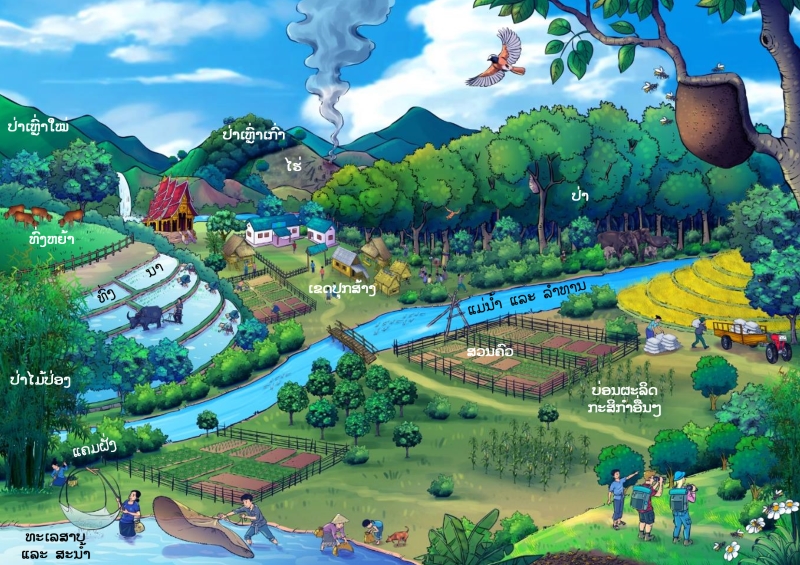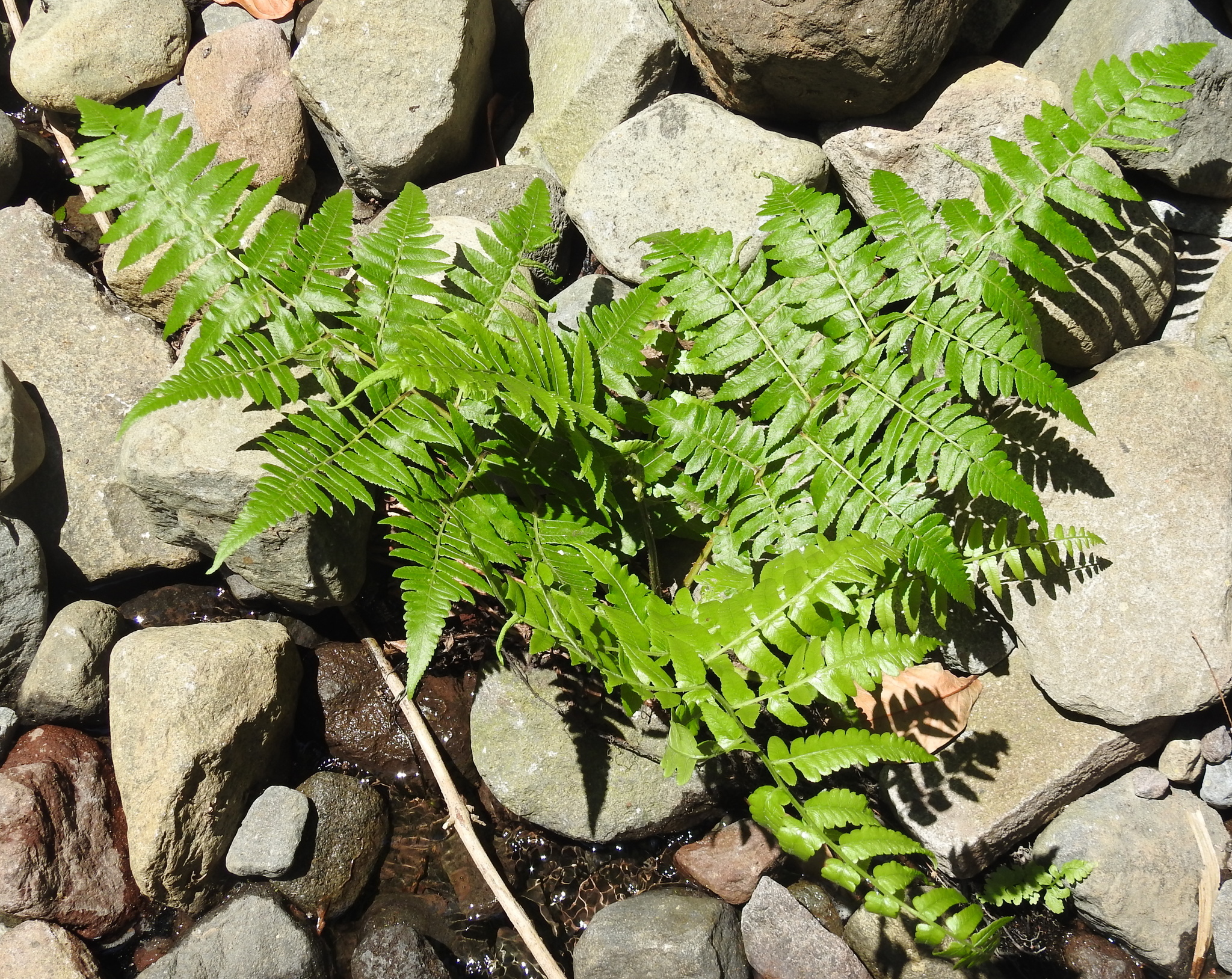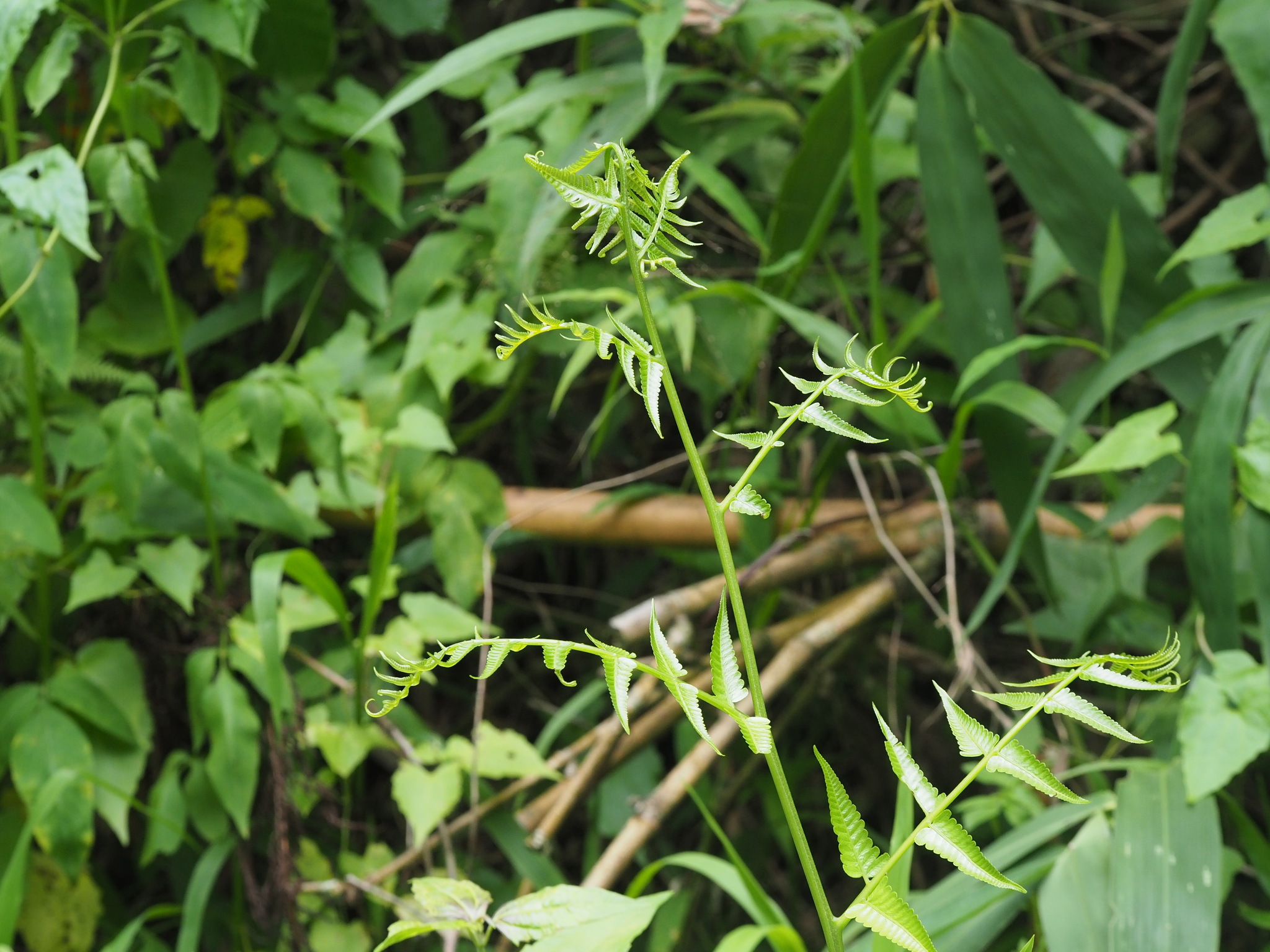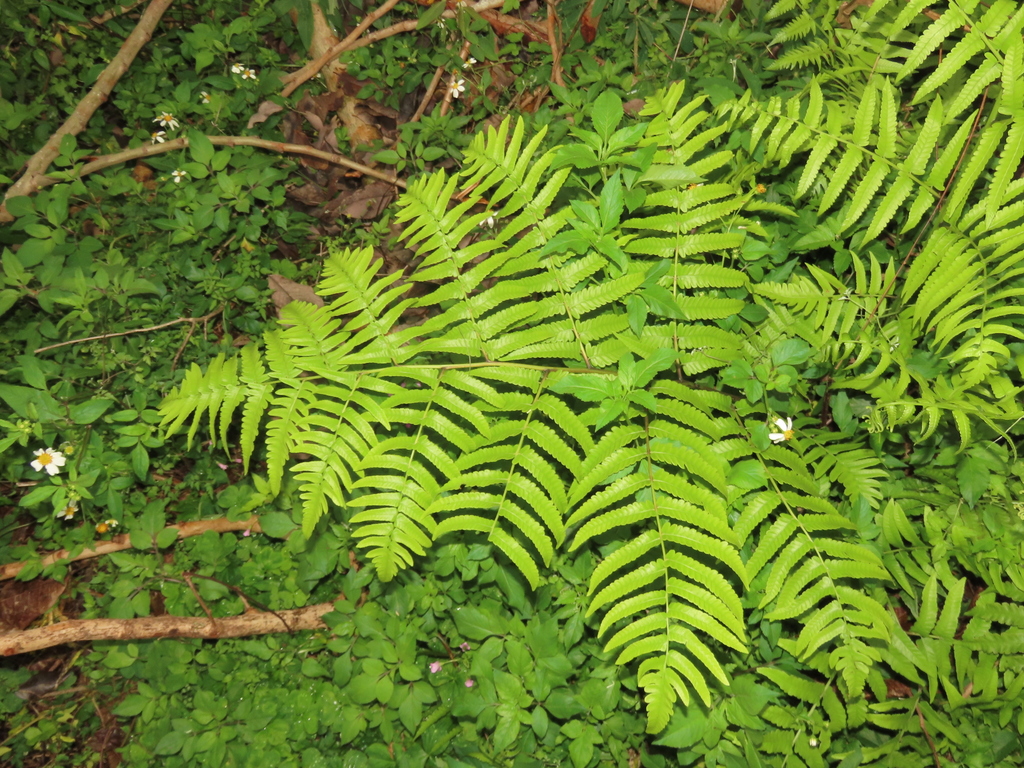ເລກລຳດັບທີ: 704
ລະດັບການຮວບຮວມຂໍ້ມູນ: ຂໍ້ມູນພື້ນຖານ
ປັບປູງຄັ້ງລ່າສຸດ: 2025-09-19
ຜັກກູດ
Fiddlehead fern
Diplazium esculentum (Retz.) Sw.
ພືດ
ພືດບໍ່ມີແກ່ນ
ຜັກກູດ
×
ຊື່ທ້ອງຖີ່ນ:
ຜັກກູດນ້ຳ ( vegetable fern)
ຊື່ພ້ອງ
:
Anisogonium esculentum (Retz.) C.Presl
Anisogonium serampurens C.Presl
Anisogonium serampurense (Spreng.) C.Presl
Anisogonium serrulatum (C.Presl) C.Presl
Asplenium ambiguum Sw.
Asplenium bipinnatum Roxb.
Asplenium esculentum (Retz.) C.Presl
Asplenium esculentum (Retz.) Wall.
Asplenium malabaricum (Spreng.) Mett.
Asplenium manilense Spreng.
Asplenium moritzii Mett.
Asplenium proliferum Wall.
Asplenium puberulum Wall.
Asplenium pubescens Mett.
Asplenium serrulatum C.Presl
Asplenium umbrosum (Moritzi) Mett.
Asplenium vitiense Baker
Athyrium ambigua (Sw.) Milde
Athyrium ambiguum (Sw.) Milde
Athyrium esculentum (Retz.) Copel.
Athyrium serrulatum (C.Presl) Milde
Callipteris ambigua (Sw.) T.Moore
Callipteris esculenta (Retz.) J.Sm.
Callipteris esculenta (Retz.) J.Sm. ex Houlston & T.Moore
Callipteris malabarica (Spreng.) J.Sm.
Callipteris serampurens (Spreng.) Fée
Callipteris serampurensis (Spreng.) Fée
Callipteris serrulata (C.Presl) Fée
Callipteris wallichii J.Sm.
Digrammaria ambigua (Sw.) Hook.
Digrammaria esculenta (Retz.) Fée
Digrammaria esculenta J.Sm.
Diplazium ambiguum (Sw.) Hook.
Diplazium malabaricum Spreng.
Diplazium manilense (Spreng. ex Kunze) C.Chr.
Diplazium serampurens Spreng.
Diplazium serampurense Spreng.
Diplazium umbrosum Moritz
Diplazium vitiense (Baker) Carruth.
Gymnogramma edulis Ces.
Hemionitis esculenta Retz.
Hemionitis incisa Blanco
Microstegia ambigua (Sw.) C.Presl
Microstegia esculenta (Retz.) C.Presl
Microstegia serrulata (C.Presl) C.Presl
Anisogonium serampurens C.Presl
Anisogonium serampurense (Spreng.) C.Presl
Anisogonium serrulatum (C.Presl) C.Presl
Asplenium ambiguum Sw.
Asplenium bipinnatum Roxb.
Asplenium esculentum (Retz.) C.Presl
Asplenium esculentum (Retz.) Wall.
Asplenium malabaricum (Spreng.) Mett.
Asplenium manilense Spreng.
Asplenium moritzii Mett.
Asplenium proliferum Wall.
Asplenium puberulum Wall.
Asplenium pubescens Mett.
Asplenium serrulatum C.Presl
Asplenium umbrosum (Moritzi) Mett.
Asplenium vitiense Baker
Athyrium ambigua (Sw.) Milde
Athyrium ambiguum (Sw.) Milde
Athyrium esculentum (Retz.) Copel.
Athyrium serrulatum (C.Presl) Milde
Callipteris ambigua (Sw.) T.Moore
Callipteris esculenta (Retz.) J.Sm.
Callipteris esculenta (Retz.) J.Sm. ex Houlston & T.Moore
Callipteris malabarica (Spreng.) J.Sm.
Callipteris serampurens (Spreng.) Fée
Callipteris serampurensis (Spreng.) Fée
Callipteris serrulata (C.Presl) Fée
Callipteris wallichii J.Sm.
Digrammaria ambigua (Sw.) Hook.
Digrammaria esculenta (Retz.) Fée
Digrammaria esculenta J.Sm.
Diplazium ambiguum (Sw.) Hook.
Diplazium malabaricum Spreng.
Diplazium manilense (Spreng. ex Kunze) C.Chr.
Diplazium serampurens Spreng.
Diplazium serampurense Spreng.
Diplazium umbrosum Moritz
Diplazium vitiense (Baker) Carruth.
Gymnogramma edulis Ces.
Hemionitis esculenta Retz.
Hemionitis incisa Blanco
Microstegia ambigua (Sw.) C.Presl
Microstegia esculenta (Retz.) C.Presl
Microstegia serrulata (C.Presl) C.Presl
ຊື່ສະກຸນ:
Athyriaceae
ຊະນິດໃກ້ຄຽງ:
ບັນຍາຍລັກສະນະທາງພືດສາດ:
ຜັກກູດຊະນິດນີ້ແມ່ນຜັກກູດຂະໜາດໃຫຍ່ ສູງໄດ້ຮອດ 1,5 ມ, ໃນສະພາບທີ່ເໝາະສົມ ສາມາດຈະເລີນເຕີບໂຕເປັນຟຸ່ມໜາ, ເຫງົ້າຕັ້ງຊື່ປົກຄຸມດ້ວຍເກັດສີນ້ຳຕານ ອາດຍາວໄດ້ຮອດ 15 ຊມ ແລະ ກວ້າງ4 ຫາ 6 ຊມ, ເຫງົ້າເຫຼົ່ານີ້ຊ່ວຍໃຫ້ພືດຈະເລີນເຕີບໂຕໄດ້ເຖິ່ງແມ່ນວ່າຈະຕັດໃບອອກກໍ່ຕາມ.
ໃບອອກຮຽງວຽນສະຫຼັບເປັນຮູບກຸຫຼາບ ແລະ ຍາວໄດ້ຮອດ 120 ຊມ, ໃບເປັນໃບປະກອບແບບຂົນນົກຂັ້ນສອງ, ມີລັກສະນະເປັນຮູບສາມຫຼ່ຽມ, ຍາວ 60 ຫາ 80 ຊມ, ປາຍໃບແຫຼມ. ແຜ່ນໃບແຕ່ລະແຜ່ນມີໃບຍ່ອຍ 12 ຫາ 16 ຊມ, ອອກຮຽງສະຫຼັບກັນ, ໃບຍ່ອຍມີເສັ້ນໃບຈຳນວນ 6 ຫາ 10 ຄູ່.
ໃບ ແລະ ກ້ານໃບລວມອາດລຽບ ຫຼື ມີຂົນ. ໂຊລິ ເຊິ່ງເປັນໂຄງສ້າງສຳຫຼັບສ້າງສະປໍ ສ່ວນໃຫຍ່ເປັນເສັ້ນຊື່ ໂຄ້ງເລັກນ້ອຍ ແລະ ປົກຄຸມເສັ້ນໃບ ມີຊັ້ນປ້ອງກັນສີເຫຼືອງ ຫາ ສີນ້ຳຕານອ່ອນ.
ແຫຼ່ງທີ່ມາ: [1]
ໃບອອກຮຽງວຽນສະຫຼັບເປັນຮູບກຸຫຼາບ ແລະ ຍາວໄດ້ຮອດ 120 ຊມ, ໃບເປັນໃບປະກອບແບບຂົນນົກຂັ້ນສອງ, ມີລັກສະນະເປັນຮູບສາມຫຼ່ຽມ, ຍາວ 60 ຫາ 80 ຊມ, ປາຍໃບແຫຼມ. ແຜ່ນໃບແຕ່ລະແຜ່ນມີໃບຍ່ອຍ 12 ຫາ 16 ຊມ, ອອກຮຽງສະຫຼັບກັນ, ໃບຍ່ອຍມີເສັ້ນໃບຈຳນວນ 6 ຫາ 10 ຄູ່.
ໃບ ແລະ ກ້ານໃບລວມອາດລຽບ ຫຼື ມີຂົນ. ໂຊລິ ເຊິ່ງເປັນໂຄງສ້າງສຳຫຼັບສ້າງສະປໍ ສ່ວນໃຫຍ່ເປັນເສັ້ນຊື່ ໂຄ້ງເລັກນ້ອຍ ແລະ ປົກຄຸມເສັ້ນໃບ ມີຊັ້ນປ້ອງກັນສີເຫຼືອງ ຫາ ສີນ້ຳຕານອ່ອນ.
ແຫຼ່ງທີ່ມາ: [1]
ນິເວດວິທະຍາ
ເຂດກະຈາຍພັນທົ່ວໂລກ:
Native to Andaman, Assam, Bangladesh, Bismarck Archipelago, Borneo, Cambodia, China, East Himalaya, Fiji, Hainan, India, Japan, Jawa, Laos, Malaya, Maluku, Myanmar, Nansei-shoto, Nepal, New Guinea, Pakistan, Philippines, Samoa, Sri Lanka, Sulawesi, Sumatera, Taiwan, Thailand, Tibet, Vanuatu, Vietnam, West Himalaya. [3]
Global distribution of the Diplazium esculentum between 2004 to 2025. Source: [2]
Global distribution of the Diplazium esculentum between 2004 to 2025. Source: [2]
ເຂດກະຈາຍພັນໃນລາວ
:
ເຂດພູສູງພາກເໜືອຂອງລາວ
ລຽບແມ່ນ້ຳຂອງພາກເໜືອ
ເຂດພູສູງສາຍພູຫຼວງ ແລະ ເຂດພູພຽງແຂວງຊຽງຂວາງ
ເຂດສາຍພູຫຼວງຕອນລຸ່ມ
ພູພຽງບໍລິເວນ
ເຂດສາຍພູຫຼວງພາກກາງ
ລຽບແມ່ນ້ຳຂອງພາກເໜືອ
ເຂດພູສູງສາຍພູຫຼວງ ແລະ ເຂດພູພຽງແຂວງຊຽງຂວາງ
ເຂດສາຍພູຫຼວງຕອນລຸ່ມ
ພູພຽງບໍລິເວນ
ເຂດສາຍພູຫຼວງພາກກາງ

ເຂດກະຈາຍພັນຕາມພູມສັນຖານ
:
ແຄມຝັ່ງນໍ້າ
ແມ່ນ້ຳ ແລະ ລຳທານ
ທະເລສາບ ແລະ ສະນ້ຳ
ໜອງບຶງ ແລະ ດິນຖານຕົມ
ທົ່ງນາ
ແມ່ນ້ຳ ແລະ ລຳທານ
ທະເລສາບ ແລະ ສະນ້ຳ
ໜອງບຶງ ແລະ ດິນຖານຕົມ
ທົ່ງນາ

ສະເພາະຖິ່ນໃນລາວ:
ພື້ນເມືອງ
ຮຸກຮານ
:
ບໍ່ຮຸກຮານ
ສະຖານະພາບການອະນູຮັກ IUCN
:
ມີຄວາມສ່ຽງໜ້ອຍສຸດ
ສະຖານະພາບການອະນຸຮັກແຫ່ງຊາດລາວ
:
ບໍ່ຖືກລະບຸໃນບັນຊີປະເພດໃດ
ການນຳໃຊ້
ປະເພດການນຳໃຊ້:
ອາຫານ
ພືດເປັນຢາ
ພືດເປັນຢາ
ບັນຍາຍການນຳໃຊ້:
ອາຫານ: ໃບອ່ອນ ແລະ ຍອດໃຊ້ເປັນຜັກ, [2]. ໃບອ່ອນສົດນຳມາຕົ້ມ, ຂົ້ວ ຫຼື ຮັບປະທານສົດພ້ອມກັບຜັກອື່ນ ຫຼື ກິນສົດດ່ຽວໆກໍ່ໄດ້. [7]
ສະໝຸນໄພ: ພືດຊະນິດນີ້ໃຊ້ໃນສະໝຸນໄພພື້ນບ້ານ ໃບນຳມາຕົ້ມເປັນຢາບຳລຸງກຳລັງສຳຫຼັບແມ່ຍິງຫຼັງເກີດ, [6]. ຮາກສາມາດນຳມາບົດ ແລະ ແຊ່ນ້ຳດື່ມໄດ້ ສ່ວນໃບອ່ອນສາມາດຕາກແຫ້ງໃນທີ່ຮົ່ມ ແລະ ເກັບໄວ້ໄດ້. [7]
ສະໝຸນໄພ: ພືດຊະນິດນີ້ໃຊ້ໃນສະໝຸນໄພພື້ນບ້ານ ໃບນຳມາຕົ້ມເປັນຢາບຳລຸງກຳລັງສຳຫຼັບແມ່ຍິງຫຼັງເກີດ, [6]. ຮາກສາມາດນຳມາບົດ ແລະ ແຊ່ນ້ຳດື່ມໄດ້ ສ່ວນໃບອ່ອນສາມາດຕາກແຫ້ງໃນທີ່ຮົ່ມ ແລະ ເກັບໄວ້ໄດ້. [7]
ການປູກ ການລ້ຽງ:
ປູກ ແລະ ທຳມະຊາດ
ລະດູການເກັບກູ້:
ພຶກສະພາ
ມິຖຸນາ
ກໍລະກົດ
ສິງຫາ
ກັນຍາ
ຕຸລາ
ມິຖຸນາ
ກໍລະກົດ
ສິງຫາ
ກັນຍາ
ຕຸລາ
ການຕະຫຼາດ ແລະ ຕ່ອງໂສ້ມູນຄ່າ:
ໃນລາວ ໂດຍສະເພາະໃນພູມີພາກຂອງຫຼວງພະບາງ ຜັກກູດຖືກວາງຂາຍກັບອາຫານປ່າຫຼາຍຊະນິດ [8]. ມີການວ່າງຂາຍໃນຕະຫຼາດທ້ອງຖິ່ນ ລາຄາທີ່ວຽງຈັນໃນຊ່ວງເດືອນພຶດສະພາ ໃນລາຄາ 5.000 ຫາ 8.000 ກີບຕໍ່ກິໂລ. [7]
ການຄຸ້ມຄອງຈັດການ
ການອານຸລັກທີ່ຢູ່ອາໄສ:
ໄພຂົ່ມຂູ່: ພືດຊະນິດນີ້ບໍ່ມີໄປຂົ່ມຂູ່ທີ່ສຳຄັນ. [4]
ການຕິດຕາມປະຊາກອນ: ເປັນຜັກກູດທີ່ສາມາດພົບເຫັນໄດ້ທົ່ວໄປ. [4]
ໄພຂົ່ມຂູ່: ພືດຊະນິດນີ້ບໍ່ມີໄປຂົ່ມຂູ່ທີ່ສຳຄັນ. [4]
ການຕິດຕາມປະຊາກອນ: ເປັນຜັກກູດທີ່ສາມາດພົບເຫັນໄດ້ທົ່ວໄປ. [4]
ໂພຊະນາການ
ຄຸນຄ່າທາງໂພຊະນາການ:
ແຫຼ່ງຄາໂບໄຮເດຣດທີ່ສຳຄັນ
ບັນຍາຍຄຸນຄ່າທາງໂພຊະນາການ:
ມີປະລິມານຄາໂບໄຮເດຣດສູູງ (59,62 ກຼາມ/100 ກຼາມ) ສະແດງໃຫ້ເຫັນວ່າຜັກກູດຊະນິດນີ້ສາມາດໃຊ້ເປັນແຫຼ່ງພະລັງງານທີ່ສຳຄັນໄດ້ ໂດຍສະເພາະໃນພູມສາດທີ່ບໍລິໂພກເປັນອາຫານຫຼັກ. [9]
| ສານອາຫານ | /100g | ໝາຍເຫດ |
|---|---|---|
| ໂປຣຕີນ | 8.73 | N/A |
| ຄາໂບໄຮເດຣດ | 59.62 | N/A |
| ໄຂມັນ | 2.16 | N/A |
| ວິຕາມິນ | N/A | N/A |
| ແຮ່ທາດ | N/A | N/A |
| ເສັ້ນໄຍ | 15.59 | N/A |
ອ້າງອິງ
ເຄດິດຮູບພາບ:
[1] iNaturalist [Online]. Uploaded on 19 August 2024 by kamleshatwal. Available: https://www.inaturalist.org/observations/236673053. [Accessed: 10 September 2024].
[2] GBIF [Online]. Uploaded on 1 March 2024 by Steve Ansell. Available: https://www.gbif.org/occurrence/4606904629. [Accessed: 10 September 2024].
[3] iNaturalist [Online]. Uploaded on 24 August 2024 by lesfreck. Available: https://www.inaturalist.org/observations/237518712. [Accessed: 10 September 2024].
[2] GBIF [Online]. Uploaded on 1 March 2024 by Steve Ansell. Available: https://www.gbif.org/occurrence/4606904629. [Accessed: 10 September 2024].
[3] iNaturalist [Online]. Uploaded on 24 August 2024 by lesfreck. Available: https://www.inaturalist.org/observations/237518712. [Accessed: 10 September 2024].
ອ້າງອິງ:
[5] Plants of the world Online [Online]. Royal Botanic Gardens, Kew. Available: https://powo.science.kew.org/taxon/urn:lsid:ipni.org:names:17086810-1. [Accessed: 10 September 2024]
[6] India Biodiversity Portal [Online]. Available: https:/indiabiodiversity.org/species/show/242436#diagnostic. [Accessed: 10 September 2024]
[7] CABI Digital Library [Online]. Available: https://www.cabidigitallibrary.org/doi/10.1079/cabicompendium.93234022. [Accessed: 10 September 2024]
[8] IUCN. (2024, September 10). IUCN red list. Retrieved from IUCN red list web site: https://www.iucnredlist.org/species/194150/8883499
[9] iNaturalist [Online]. Available: https://www.inaturalist.org/taxa/161950-Diplazium-esculentum. [Accessed: 11 September 2024]
[10] P. Semwal, S. Painuli, K.M. Painuli, G. Antika, T. B. Tumer, A. Thapliyal, et al., "Diplazium esculentum (Retz.) Sw.: Ethnomedici-nal, Phytochemical, and Pharmacological Overview of the Himalayan Ferns" Hindawi Oxidative Medicine and Cellular Longevity, vol. 2021, pp. 1-15, September 2021.
[11] G. Kumar Dash, S. Jusof Khadidi & A.F. Shamsuddin, " Pharmacognostic Studies On Diplazium Esculentum (Retz.) Sw." Scholars Research Library, vol.9, pp. 113-120, 2021.
[12] Plants For A Future [Online]. Available: https://pfaf.org/user/Plant.aspx?LatinName=Diplazium+esculentum. [Accessed: 12 September 2024]
[13] World’s Largest Farmers Network Agrownet Transforming Agriculture [Online]. Available: https://www.agrownet.com/contents/en-us/p196_Diplazium-esculentum_Cultivation_agrownet_Diplazium-esculentum_crop_management.html. [Accessed: 12 September 2024]
[14] P. Trail, Y. Danmalidoi, A. Bicksler. & R. Burnette (2021, March). Production of Vegetable Fern (Diplazium esculentum Reytz.) Under Varying Levels of Shade [Online]. Available: https://www.echocommunity.org/en/resources/390f2f8b-9835-444e-bfed-6f96abe3b9ec.
[15] A.G. Nair, S. Pradeesh, G.S. Nikhila, G. Sangeetha, I.I. Mini. & Swapna, T.S, "CONSERVATION OF VEGETABLE FERN (DIPLAZIUM ESCULENTUM ) OF WESTERN GHATS THROUGH IN VITRO SPORE CULTURE" Journal of Aquatic Biology and Fisheries, vol. 2, pp. 43-50, December 2013.
[16] S. Roy1. & T.K. Chaudhuri. (2020, October). “A comprehensive review on the pharmacological properties of Diplazium esculentum, an edible fern”. Journal of Pharmaceutics and Pharmacology Research [Online]. vol. 3, issue 1. Available: https://auctoresonline.org/uploads/articles/1626517435A_comprehensive_review_on_the_pharmacological_properties_of_Diplazium_esculentum.pdf.
[17] Ł. Łuczaj, V. Lamxay, K. Tongchan, K. Xayphakatsa, K. Phimmakong, S. Radavanh, V. Kanyasone, M. Pietras & M. Karbarz. (2021, January). “Wild food plants and fungi sold in the markets of Luang Prabang, Lao PDR”. Journal of Ethnobiology and Ethnomedicine [Online]. vol.6. Available: https://ethnobiomed.biomedcentral.com/articles/10.1186/s13002-020-00423-y
[6] India Biodiversity Portal [Online]. Available: https:/indiabiodiversity.org/species/show/242436#diagnostic. [Accessed: 10 September 2024]
[7] CABI Digital Library [Online]. Available: https://www.cabidigitallibrary.org/doi/10.1079/cabicompendium.93234022. [Accessed: 10 September 2024]
[8] IUCN. (2024, September 10). IUCN red list. Retrieved from IUCN red list web site: https://www.iucnredlist.org/species/194150/8883499
[9] iNaturalist [Online]. Available: https://www.inaturalist.org/taxa/161950-Diplazium-esculentum. [Accessed: 11 September 2024]
[10] P. Semwal, S. Painuli, K.M. Painuli, G. Antika, T. B. Tumer, A. Thapliyal, et al., "Diplazium esculentum (Retz.) Sw.: Ethnomedici-nal, Phytochemical, and Pharmacological Overview of the Himalayan Ferns" Hindawi Oxidative Medicine and Cellular Longevity, vol. 2021, pp. 1-15, September 2021.
[11] G. Kumar Dash, S. Jusof Khadidi & A.F. Shamsuddin, " Pharmacognostic Studies On Diplazium Esculentum (Retz.) Sw." Scholars Research Library, vol.9, pp. 113-120, 2021.
[12] Plants For A Future [Online]. Available: https://pfaf.org/user/Plant.aspx?LatinName=Diplazium+esculentum. [Accessed: 12 September 2024]
[13] World’s Largest Farmers Network Agrownet Transforming Agriculture [Online]. Available: https://www.agrownet.com/contents/en-us/p196_Diplazium-esculentum_Cultivation_agrownet_Diplazium-esculentum_crop_management.html. [Accessed: 12 September 2024]
[14] P. Trail, Y. Danmalidoi, A. Bicksler. & R. Burnette (2021, March). Production of Vegetable Fern (Diplazium esculentum Reytz.) Under Varying Levels of Shade [Online]. Available: https://www.echocommunity.org/en/resources/390f2f8b-9835-444e-bfed-6f96abe3b9ec.
[15] A.G. Nair, S. Pradeesh, G.S. Nikhila, G. Sangeetha, I.I. Mini. & Swapna, T.S, "CONSERVATION OF VEGETABLE FERN (DIPLAZIUM ESCULENTUM ) OF WESTERN GHATS THROUGH IN VITRO SPORE CULTURE" Journal of Aquatic Biology and Fisheries, vol. 2, pp. 43-50, December 2013.
[16] S. Roy1. & T.K. Chaudhuri. (2020, October). “A comprehensive review on the pharmacological properties of Diplazium esculentum, an edible fern”. Journal of Pharmaceutics and Pharmacology Research [Online]. vol. 3, issue 1. Available: https://auctoresonline.org/uploads/articles/1626517435A_comprehensive_review_on_the_pharmacological_properties_of_Diplazium_esculentum.pdf.
[17] Ł. Łuczaj, V. Lamxay, K. Tongchan, K. Xayphakatsa, K. Phimmakong, S. Radavanh, V. Kanyasone, M. Pietras & M. Karbarz. (2021, January). “Wild food plants and fungi sold in the markets of Luang Prabang, Lao PDR”. Journal of Ethnobiology and Ethnomedicine [Online]. vol.6. Available: https://ethnobiomed.biomedcentral.com/articles/10.1186/s13002-020-00423-y
ຜູ້ສ້າງ Factsheet:
Keooudone Souvannakhoummane
ຜູ້ກວດສອບ Factsheet:
,


